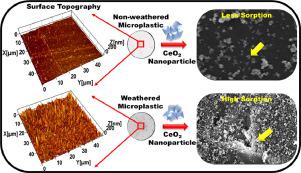Water Research ( IF 12.8 ) Pub Date : 2020-11-09 , DOI: 10.1016/j.watres.2020.116622 Nisha Singh , Nitin Khandelwal , Ekta Tiwari , Nabanita Naskar , Susanta Lahiri , Johannes Lützenkirchen , Gopala Krishna Darbha

|
The ubiquitous distribution of microplastics (MPs) leads to inevitable interactions with the toxic pollutants present in the environment including metal-oxide nanoparticles. This study investigates the interaction of CeO2 nanoparticles (CeNPs) with MPs generated from a disposable plastic container. Further, rough MPs (R-MPs), generated through mechanical abrasion of MPs with sand, were used to probe the impact of roughness. To understand the sorption kinetics and underlying interaction processes, batch experiments were carried out. The results distinctly indicate that CeNPs sorption occurred on MPs surfaces and was consistent with the pseudo-second order kinetics model. For pristine MPs, the sorption capacity was as high as 12.9 mg/g while for R-MPs kinetic equilibrium was achieved faster and an enhanced sorption capacity (13.4 mg/g) was identified. A rise in sorption with an increase in salinity was noted while pH and humic acid exhibited a negative correlation. The observed interactions were attributed to the aggregation profile and surface charge of CeNPs and MPs. Surprisingly, CeNPs also got loaded onto MPs in non-agitated and undisturbed conditions. The sorption process was influenced by the type of aqueous matrix and the sorption capacity at equilibrium followed the trend: distilled water> synthetic freshwater> river water. FTIR spectra, zeta potential, SEM imaging, and elemental mapping revealed electrostatic interaction as the dominant mechanism. This work contributes towards the knowledge gap on the environmental risk of MPs.
中文翻译:

金属氧化物纳米粒子与微塑料的相互作用:河道条件下风化的影响
微塑料(MPs)的普遍分布导致与环境中存在的有毒污染物(包括金属氧化物纳米颗粒)发生不可避免的相互作用。这项研究调查了CeO 2的相互作用从一次性塑料容器中产生MP的纳米颗粒(CeNPs)。此外,通过用沙子对MP进行机械磨损而产生的粗糙MP(R-MP)被用来探测粗糙度的影响。为了了解吸附动力学和潜在的相互作用过程,进行了批量实验。结果清楚地表明,CeNPs吸附发生在MPs表面,并且与假二级动力学模型一致。原始MPs的吸附容量高达12.9 mg / g,而R-MPs的动力学平衡更快,并且鉴定出增强的吸附容量(13.4 mg / g)。注意到随着盐度的增加吸附的增加,而pH和腐殖酸显示出负相关。观察到的相互作用归因于CeNPs和MPs的聚集分布和表面电荷。出人意料的是,CeNPs在不受干扰和不受干扰的条件下也被装载到MPs上。吸附过程受水基体类型的影响,平衡时的吸附能力遵循以下趋势:蒸馏水>合成淡水>河水。FTIR光谱,ζ电位,SEM成像和元素图谱显示静电相互作用是主要机理。这项工作加剧了议员对环境风险的知识差距。河水。FTIR光谱,ζ电位,SEM成像和元素图谱显示静电相互作用是主要机理。这项工作加剧了议员对环境风险的知识差距。河水。FTIR光谱,ζ电位,SEM成像和元素图谱显示静电相互作用是主要机理。这项工作加剧了议员对环境风险的知识差距。


























 京公网安备 11010802027423号
京公网安备 11010802027423号